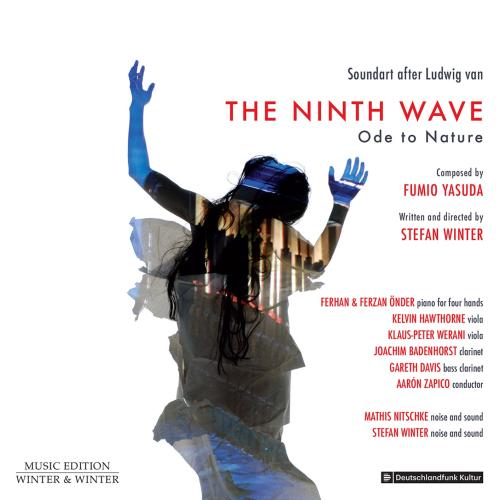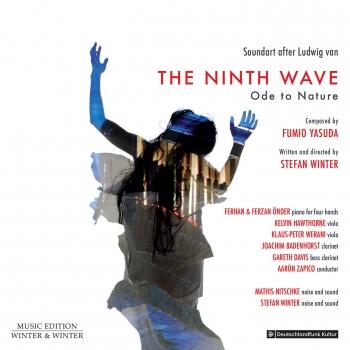
The Ninth Wave Various Artists - The Ninth Wave
Album Info
Album Veröffentlichung:
2022
HRA-Veröffentlichung:
09.08.2022
Label: Winter and Winter
Genre: Classical
Subgenre: Chamber Music
Interpret: Various Artists - The Ninth Wave
Komponist: Fumio Yasuda (1953)
Das Album enthält Albumcover Booklet (PDF)
- Fumio Yasuda (b. 1953), Stefan Winter (b. 1958): The Ninth Wave (Ode to Nature), Pt. 1 "Infinite Blue":
- 1 Yasuda, Winter: The Ninth Wave (Ode to Nature), Pt. 1 "Infinite Blue": I. Water and Air [After L.V. Beethoven Op. 112] 09:18
- 2 Winter, Yasuda: The Ninth Wave (Ode to Nature), Pt. 1 "Infinite Blue": II. Afterlife [After L.V. Beethoven Op. 109] 10:00
- 3 Winter, Yasuda: The Ninth Wave (Ode to Nature), Pt. 1 "Infinite Blue": III. Seafoam [After L.V. Beethoven Opp. 131 & 134] 09:49
- The Ninth Wave (Ode to Nature), Pt. 2 "Deep Green":
- 4 Winter, Yasuda: The Ninth Wave (Ode to Nature), Pt. 2 "Deep Green": I. Forest [After L.V. Beethoven Op. 72] 10:00
- 5 Winter, Yasuda: The Ninth Wave (Ode to Nature), Pt. 2 "Deep Green": II. Wandering [After L.V. Beethoven Op. 67] 09:49
- 6 Winter, Yasuda: The Ninth Wave (Ode to Nature), Pt. 2 "Deep Green": III. Under the Waterfall [After L.V. Beethoven Op. 123] 09:30
- The Ninth Wave (Ode to Nature), Pt. 3 "Red Zone":
- 7 Winter, Yasuda: The Ninth Wave (Ode to Nature), Pt. 3 "Red Zone": I. At the Bank of River Styx [After L.V. Beethoven Op. 92] 09:46
- 8 Winter, Yasuda: The Ninth Wave (Ode to Nature), Pt. 3 "Red Zone": II. Red Rain [After L.V. Beethoven Op. 72] 08:50
- 9 Winter, Yasuda: The Ninth Wave (Ode to Nature), Pt. 3 "Red Zone": III. The Great Wave [After L.V. Beethoven Op. 125] 09:36
Info zu The Ninth Wave
Fumio Yasuda (composition) and Stefan Winter (sound art) conceive a trilogy based on Ludwig van in the timbres “Infinite Blue”, “Deep Green” and “Zone Red”. The Ninth Wave is about the beauty of nature and the tragedy of the human within it. "Beethoven as a total work of art" was the headline in the Seuddeutsche Zeitung when "The Ninth Wave" was produced in Munich. Beethoven's oeuvre, Géricault's "Medusa's Raft" and Dante's "Divine Comedy" are to blame for this work ... but there is also a concrete trigger: the tragedy off Lampedusa on October 3, 2013.
A symphony of fabulous sounds, noises, music and film poems about the beauty of nature and the tragedy of the mankind. Sounds and film with live music offer a new experience beyond opera, film and concert. The result is an extraordinary poetry of living images and movement in combination with nine adaptations after Ludwig van Beethoven and the moving narrative power of sounds.
The three elements music, sound and film are created independently of each other to form a new unity. Fragments of the avant-garde Great Fugue resound, nature begins to pulsate ... and Venus rises from the sea foam.
Crazy Beethovenian music fills the room. Noise and buzz come up, but they are pure illusion and not reality. Every sound is animation, every noise is created live by human hands.
In the center of the action, colors [Infinite Blue, Deep Green, Zone Red] appear on the body of a female sculpture that comes to life and experiences nine allegories [Creation, Finiteness, Beauty, Forlornness, Flight, Search, Powerlessness, Hatred, Desolation].
Nine individual scenes, each nine minutes long, self-contained but highly interrelated, form a trilogy with three main parts.
The work has a concrete trigger in the recent past: the tragedy on October 3, 2013 near the island of Lampedusa.
Aarón Zapico, conductor
Ferhan & Ferzan Önder, piano
Kelvin Hawthorne, viola
Klaus-Peter Werani, viola
Joachim Badenhorst, clarinet
Gareth Davis, bass clarinet
Mathis Nitschke, sound and noise
Stefan Winter, sound and noise
The Ninth Wave — Ode To Nature is a carefully directed composition of a film poem with adaptations of environmental sounds and music, dealing with the destruction of nature, neo-colonialism and human behaviour in general and its effects.
The Ninth Wave is about the destruction of nature and general human behaviour and its effects.
Nine individual scenes, each nine minutes long, form three trilogies: Infinite Blue, Deep Green and Zone Red.
Nine sculptures come to life and embody creation, finiteness, beauty, forlornness, flight, search, powerlessness, hatred, desolation and again new creation. Breathtaking, fantastic images appear on their bodies, reflecting from their innermost being.
The work has a concrete trigger: the refugee tragedy on October 3, 2013 in front of Lampedusa. Memories of Beethoven's "Ninth", the meaning of the last movement, chosen as the European anthem, Géricault's "Raft of Medusa" and Dante's "Divine Comedy" come to mind. The Ninth Wave is sound art about the beauty of nature and the tragedy of the human being in it. An extraordinary interplay of colour, dance, film, sound and music performance.
The number Nine stands for the triple triad, the completion, the fulfillment, the totality, beginning and end, the earthly paradise. The number Nine signifies the highest vibration. According to sailor's wisdom, the ocean waves build up in growing triple rhythms, the ninth becomes the most powerful. The Divine Comedy by Dante leads into the nine circles of hell. The Flood in the Age of Deucalion, with which Zeus punishes the first humanity, lasts nine days and nights.
The first trilogy is called Infinite Blue: As the colour of the sky, blue expresses distance, vastness and infinity. As the colour of water, blue symbolizes the soul, the feminine side (of nature), the unconscious, the unknown, longing and clarity. The colour blue stands for eternity and endlessness, the sky, the unfathomable depth of the water and the seas. In ritual ceremonies in magic, blue is used to seek wisdom, reconciliation, understanding, harmony, peace or inner light. The earth is the blue planet, huge oceans span the world and shine in blue clarity.
The second trilogy is called Deep Green: As a colour of hope, green expresses contentment, confidence and fertility. Green is created by mixing blue with yellow, the colour of the sky and water with the colour of light. Thus the colour green combines the colour blue with the emotional warmth of the sun. Both together create growth and enable new life. In addition, in contrast to the colour red, the colour green signals open access, the free path.
The third trilogy is called Zone Red: As the colour of fire and blood, red stands for destruction, danger, anger, seduction and the forbidden. Red is associated with the male sex, with struggle, war and hatred. Red signals forbid access, red signals block the free way.
Images reflect on faces, skin surfaces and bodies of the dancer Aki Tsujita, a living sculpture embodying nine allegories. Only fragments of the images mirroring on her body remain visible. The result are abstract, living paintings in interaction with music and the narrative power of noises.
Fumio Yasuda, who has been working with director and author Stefan Winter for 20 years, has composed the new musical work The Ninth Wave. In total, nine nine-minute movements are created after the Cantata Calm Sea and a Prosperous Voyage, Piano Sonata no. 30 op. 109, String Quartet No. 14, op. 131, Great Fugue, op. 134, Prisoners' choir from the opera Fidelio, 2nd Movement, 5th Symphony, op. 67, Benedictus, Missa Solemnis, op. 123, 2nd Movement, 7th Symphony, op. 92 and 4th movement, Ode to Joy, 9th Symphony, op. 125.
The musical work does not serve as a background or soundtrack to the installation of the living images, but forms a total work of art with the visual world and environmental sounds.
Sounds and living images recall the past and awaken to a new symphony in new movements. In rhythms of three, nine waves grow, each more powerful than the last, the ninth that comes from the depths, is slowly rising, grows to the highest dimension, screams and lets the whole world sink in red sun.
Keine Biografie vorhanden.
Booklet für The Ninth Wave











